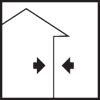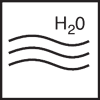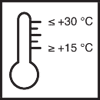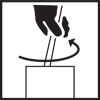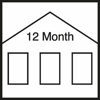Article No. 791805
Water-based, opaque insulating primer and intermediate coat for spray application

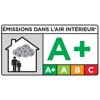
Product specifications
The stated values represent typical product characteristics and are not to be construed as binding product specifications.
Field of application
- For use on interior and exterior wood
- Soft and hard woods
- Dimensionally stable wood building elements: e.g. windows and doors
- Primer and intermediate coat
Properties
- Good flow properties
- Good build on the surface
- Good pore wetting performance
- Excellent protection against discolouration caused by water-soluble substances contained in the wood
- Excellent protection against surface defects caused by substances contained in specific types of wood (e.g. larch)
- Very good adhesion to the substrate
- Flexible tinting helps to provide the ideal colour match with final coats
-
Preparation
-
Substrate requirements
The substrate must be clean, dry, free of dust, grease and loose substances, and prepared in the correct manner.
Dimensionally stable wood building elements: wood moisture content 11-15%
-
Preparations
If necessary, impregnate non-resistant woods with a wood preservative* (*Use biocides safely. Always read the label and product information before use).
Prime wood surfaces.
If necessary, protect parapet joints with Induline V-Joint Protection or Induline AF-920.
-
-
Application
-
The values given are based on undiluted material. The best spraying pattern is achieved if the material has a temperature of 15-20 °C.
If necessary, check compatibility with the substrate and sealing effect by applying a trial coat.
Airless spraying: nozzle size: 0.28-0.33 mm; material pressure: 90-120 bar.
Air-mix spraying: nozzle size: 0.28-0.33 mm; material pressure: 70-90 bar, atomiser air pressure 1-2 bar.
After priming, carry out light intermediate sanding.
Carry out intermediate sanding before applying a final coat: P 220-240, remove sanding dust.
Seal opened containers well and use contents as soon as possible.
-
Application instructions
-
Check colour, adhesion and compatibility with the substrate by setting up a trial area.
Before coating technically modified woods and wood-based materials, apply the product to a trial surface and conduct a suitability test on the desired area of use.
Ensure good ventilation.
With water based coating systems, there is always a residual risk that substances contained in the wood will cause discolouration.
Bleeding resin is a natural phenomenon and cannot be prevented by coating measures, see BFS Code of Practice No. 18.
The product's sealing effect may be impaired if it is diluted too thinly, if the wood is too wet or if the recommended coating sequence, application volumes and drying times are not observed.
Observe current standards and guidelines for coating wood building elements outdoors (Codes of Practice issued by the German Association of Window and Facade Manufacturers (VFF), Code of Practice No. 18 issued by the German Federal Committee for Paint and the Protection of Material Assets (BFS), guidelines issued by the German Lacquer and Printing Ink Association (VdL) and ift guidelines issued by the Institut für Fenstertechnik).
The system finder on our website www.remmers.com contains coating recommendations for specific wood types to be used when treating windows and exterior doors.
-
Drying
Dust dry: after approx. 30 mins
Can be sanded and overcoated: after approx. 4 hours
(at 23 °C and 50% RH)
When forced drying is applied, can be sanded and overcoated: after 20 mins flash-off time (at approx. 20 °C and 65-75% RH/75 mins drying time (approx. 45 °C, 1 m/s air circulation)/20 mins cooling time.Low temperatures, poor ventilation and high humidity delay drying.
-
Thinning
If necessary with water (max. 5%).
-
Working tools / cleaning
-
Hand spray guns, automatic spraying equipment.
-
Clean tools with water or Aqua RK-898 Cleaning Concentrate immediately after use.
Ensure that any residue from cleaning is disposed of correctly.
-
Storage / shelf life
-
If stored unopened in its original container in a cool, dry place and protected against frost, the product will keep for at least 12 months.
-
Usage
-
150 - 200 ml/m² per coat
(corresponds to a wet film thickness of 150 - 200 μm and a dry film thickness of 60 - 85 μm)
-
General information
-
Sealing compounds must be compatible with the coating and may only be applied once the coating has dried thoroughly.
Only use sealing profiles that are free of plasticisers.
Wood building elements which have been treated with an intermediate coating should not be exposed to weathering until a finishing coat has been applied.
Depending on the desired final colour (e.g. when using Induline DW-625), Induline ZW-425 can be used specifically in one of 4 basic colours.
This allows the colour accuracy, colour brilliance, hiding power/clouding to be optimised.
This is particularly important for colours from the yellow, red, orange and green colour spaces which are naturally less opaque.
The classification below can be used to select a specific colour for the intermediate coat, depending on the colour of the finishing coat:
RAL 1000-1037: FT42553 cream
RAL 2000-2012: FT42553 cream
RAL 3000-3031: FT42553 cream
RAL 4001-4010: FT42554 light grey
RAL 5000-5004, 5008, 5010-5011, 5013, 5020, 5022: FT42555 dark grey
RAL 5005-5007, 5009, 5012, 5014-5019, 5021, 5023-5024: FT42554 light grey
RAL 6000, RAL 6017-6019, 6021, 6024-6025, 6027, 6029-6034: standard white
RAL 6001-6003, 6010-6011, 6016, 6026, 6028: FT42554 light grey
RAL 6004 - 6009, 6012, 6014 - 6015, 6020, 6022: FT 42555 dark grey
RAL 6013: RAL 7001 pigmentation
RAL 7000-7013, 7023, 7030, 7033, 7036-7037, 7039-7043, 7045-7046: FT 42554 light grey
RAL 7015-7022, 7024-7026, 7031: FT 42555 dark grey
RAL 7032, 7034-7035, 7038, 7044, 7047: standard white
RAL 8000-8008, 8023 - 8028: FT 42554 light grey
RAL 8011-8022: FT 42555 dark grey
RAL 9001-9003, 9010, 9016, 9018: standard white
RAL 9004-9005, 9011, 9017: FT 42555 dark grey
RAL 9006-9007: FT 42554 light grey
-
-
Disposal instructions
-
Larger quantities of leftover product should be disposed of in the original containers in accordance with the applicable regulations. Completely empty, clean containers should be recycled. Do not dispose of together with household waste. Do not allow to enter the sewage system. Do not empty into drains.
-
-
Safety / regulations
-
For further information on the safety aspects of transporting, storing and handling the product and on disposal and environmental matters, please see the current Safety Data Sheet.
-


















